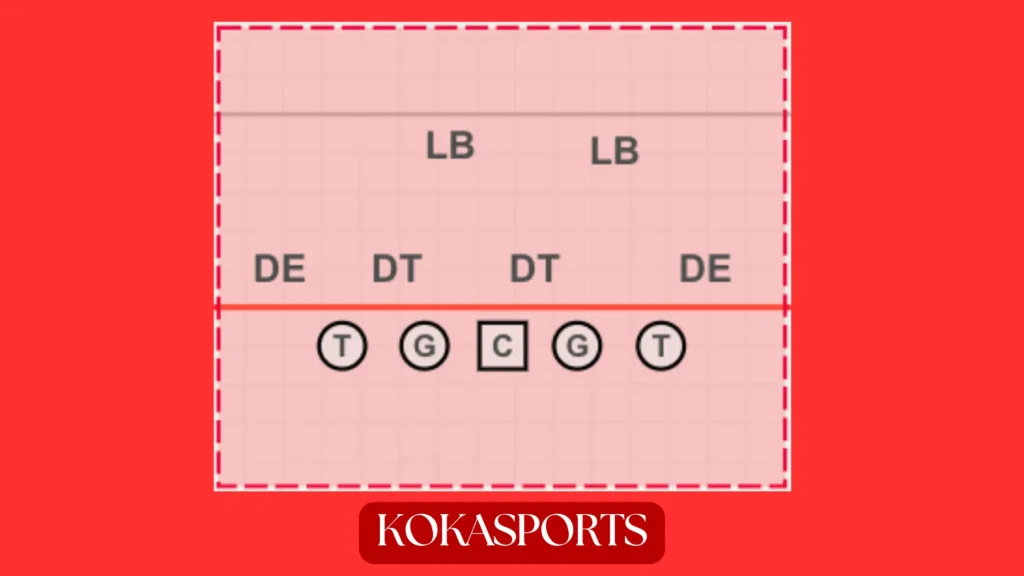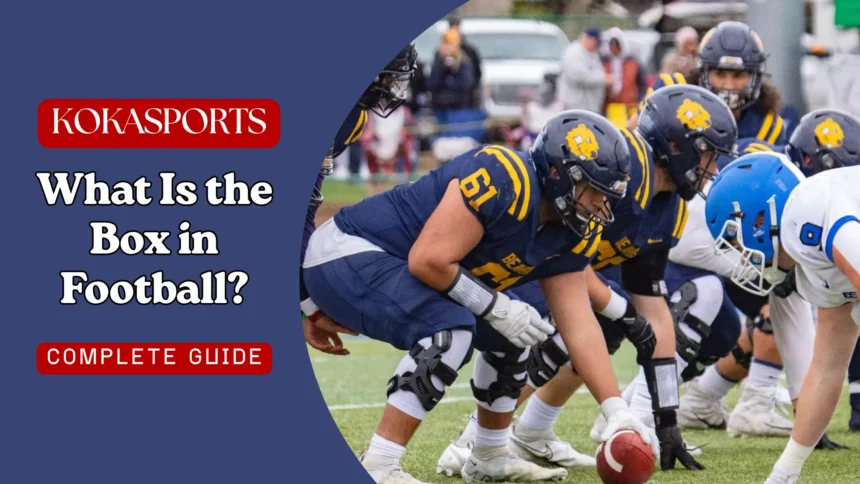When you watch an American football game, commentators constantly mention “the box in football.” But what exactly does this term mean? Why do coaches obsess over it? The box represents an imaginary rectangular area near the line of scrimmage where the most physical battles happen on every single play.
This zone determines whether teams can run the ball effectively, control the clock, and win games. The box extends from offensive tackle to offensive tackle, roughly 10 yards wide, and goes about 5-7 yards deep into the defensive side of the field. Every snap, both teams fight to control this critical area. Let’s dive into everything you need to know about the box and why it matters so much in American football.
What Exactly Is the Box in Football?

The box in football is an imaginary rectangular area where offensive and defensive lines collide. Picture a rectangle starting at the line of scrimmage, stretching from one offensive tackle to the other offensive tackle, and extending 5-7 yards back into defensive territory. This zone isn’t marked with lines on the football field, but every player, coach, and serious fan knows exactly where it is.
Inside this area, defensive linemen, linebackers, and sometimes safeties position themselves to stop running plays. Meanwhile, the offensive lineman and running backs work together to create holes and gain yards. The physical battles in this zone determine game outcomes more than any other area on the football field.
Key facts about the box:
- Width: From offensive tackle to offensive tackle (about 10 yards)
- Depth: 5-7 yards from the line of scrimmage
- Players involved: Offensive line, defensive line, linebackers, running backs
- Purpose: Primary area where running plays develop and get stopped
The box changes size based on formations. When offenses spread wide receivers across the field, the box naturally shrinks because defenders must cover more ground. When offenses use tight formations with multiple tight ends, the box can expand slightly. This flexibility makes the box a dynamic tactical element rather than a fixed zone.
Read More: What Is a Tackle Box in Football? Complete Guide to the Tackle Box Rule in American Football
Stack the Box: The Ultimate Run-Stopping Strategy
When defensive coordinators want to stop the run aggressively, they stack the box. This means loading the box with extra defenders beyond the normal 6-7 players. A stacked box might contain 8 or even 9 defenders near the line, creating a numerical advantage against the offense.
Think about simple math. If the offense brings 7 blockers (5 linemen, a tight end, and a fullback) and the defense puts 9 defenders in the box, the offense faces a 9-on-7 situation. That’s tough odds for any running play. However, stacking the box creates a major weakness: it leaves wide receivers in single coverage with fewer defenders to help.
When teams stack the box:
- Short yardage: Need 1-2 yards for a first down
- Goal line situations: Defense protecting the end zone
- Run-heavy opponents: Against teams that run 60%+ of plays
- Bad weather: Rain, snow, or wind makes passing difficult
- Clock situations: Late game when offense must run
The Risk and Reward of Stacking
Coaches who stack the box make a calculated gamble. They’re betting the offense will run the ball, and they want to stuff it for no gain or a loss. When it works, the offense faces second-and-long or third-and-long situations where passing becomes necessary. This gives the defense a huge advantage.
But when it backfires, the results can be devastating. If the quarterback recognizes the stacked box and changes to a pass play, wide receivers often run free against single coverage. A quick throw can turn into a 20, 30, or even 60-yard gain because fewer defenders are in the box means fewer players protecting against passes.
“You stack the box, you better be right. Miss that call, and you’re watching the offense celebrate in your end zone.” – NFL Defensive Coordinator
How Offenses Attack Defenders in the Box

Smart offensive coordinators have multiple weapons to counter defenders in the box. They use formations, play calling, and pre-snap adjustments to create advantages. Let’s explore the main strategies:
Formation Manipulation
The easiest way to reduce players in the box is spreading receivers wide. When four or five receivers line up away from the center, defenses must respond. They can’t keep 8-9 defenders in the box because wide receivers would run completely uncovered. This forces the defense into fewer players in the box, creating better odds for running plays.
Empty backfield formations are particularly effective. With all five eligible receivers spread out, defenses typically pull back to 5-6 defenders in the box. This creates numerical advantages for the offense, especially for quarterback run plays or quick passes.
Heavy formations with multiple tight ends work differently. They invite the defense to add more defenders near the line, then use power blocking to create holes. Some teams use two or three tight ends plus a fullback, accepting the challenge of running against a stacked box with superior blocking.
Play Action: Using the Box Against Itself
When a team establishes they can run the ball effectively, play action becomes a devastating weapon. The quarterback fakes a handoff to the running back, and defenders near the line bite on the fake. They take steps forward to stop the run, only to realize it’s a pass. By then, receivers are running past them downfield.
Play action works because defenses must respect the run threat. If your team gains 5-6 yards per carry, defenders must commit to stopping the run. That commitment creates opportunities for play action passes. The better your running game, the more effective your play action becomes.
Quick Passes Beat Aggressive Boxes
When defenses stack the box and rush aggressively, quick passes neutralize their advantage. The quarterback takes a short drop (3-5 steps) and throws to a receiver running a quick route. The ball comes out in 2.0-2.5 seconds, before the pass rush can reach the quarterback.
These passes attack the space created when defenders commit to run support. If 8-9 players crowd the box, only 2-3 defenders cover four or five receivers. That’s advantageous math for the offense. Wide receivers find soft spots in the defense and catch easy completions for 5-8 yards consistently.
The Critical Role of the Offensive Lineman
Every offensive lineman lives and dies in the box. These massive players, typically weighing 300-330 pounds, form the foundation of every offense. Their job seems simple but requires incredible technique, strength, and intelligence.
Five offensive linemen work together as a unit:
- Center: Snaps the ball, calls protection schemes
- Guards (2): Block defensive tackles, pull on running plays
- Tackles (2): Protect quarterback’s blind side, seal the edge on runs
Blocking Schemes in the Box
Different blocking schemes create different advantages:
Power Blocking: The most physical approach. Offensive linemen drive defenders backward through brute force. Often includes a pulling guard or fullback leading the running back through the hole. Works best when you have a physical advantage and want to impose your will.
Zone Blocking: Linemen block areas rather than specific defenders. They take steps in one direction, engaging whoever appears in their zone. The running back reads these blocks and finds the best running lane. This scheme works well against aggressive defenders in the box who can be sealed away from the play.
Pull Blocking: Guards or even tackles pull from their position and lead the running back around the edge or through a different gap. This creates angles and gets athletic linemen in space against linebackers. Very effective against defenses that stack the box because it attacks where they’re vulnerable.
Combination Blocking: Two linemen work together on one defender before one releases to the second level. This handles powerful defensive tackles who would otherwise disrupt plays. Critical against defenses that put multiple defenders in the box.
The Battle Behind the Line of Scrimmage
Most plays get decided behind the line of scrimmage or within 2-3 yards past it. When offensive linemen win their blocks and create vertical push, running backs have clear lanes. They can run downhill, gain 4-6 yards, and keep the offense ahead of the chains.
When defenders win, they penetrate into the backfield, making tackles behind the line of scrimmage for losses. This creates second-and-12 or third-and-9 situations that heavily favor the defense. Losing battles in the box destroys offensive rhythm and forces teams into obvious passing situations.
Key Statistics: Why Box Control Wins Games
Numbers prove the box determines outcomes:
| Success Metric | Win Percentage | Impact |
|---|---|---|
| Average 4+ yards per rush | 70% | Controls clock and creates manageable third downs |
| Hold opponent under 3.5 yards per rush | 65% | Forces predictable passing situations |
| Win time of possession | 80% | Keeps your defense fresh, wears out theirs |
| Create third downs of 5 yards or less | 68% | High conversion rate keeps drives alive |
These statistics reveal why coaches obsess over the box. When your team runs the ball effectively (4+ yards per carry), you win 7 out of 10 games. When you stop opponents’ running game, you win nearly two-thirds of your games. The box isn’t everything, but it’s the foundation of winning football.
Defensive Schemes: Different Approaches to the Box
Different defensive systems position players in the box differently:
4-3 Defense: The Balanced Approach
The 4-3 uses four defensive linemen and three linebackers, naturally putting 7 players in the box. This scheme balances run defense and pass coverage effectively. It’s been the NFL‘s most popular defense for decades because it handles most situations well without major weaknesses.
3-4 Defense: Versatility and Disguise
The 3-4 uses three defensive linemen and four linebackers. It still puts 7 defenders in the box but offers more flexibility. Linebackers can rush the quarterback or drop into coverage, making it harder for offenses to predict. This disguise creates uncertainty for quarterbacks reading the box before the snap.
Bear Front / 46 Defense: Ultimate Aggression
This aggressive scheme puts 8-9 defenders in the box, daring offenses to throw. The Chicago Bears made this famous in 1985, dominating opponents by forcing them to beat their box. They allowed just 12.4 points per game and won the Super Bowl. However, modern passing attacks have made this scheme riskier.
Nickel and Dime: Accepting the Run
Against pass-heavy teams, defenses use nickel (5 defensive backs) or dime (6 defensive backs) packages. This creates fewer players in the box only 5-6 defenders accepting that some running plays might gain yards to better defend passes. Used extensively in today’s pass-first NFL.
Reading the Box: Pre-Snap Keys
Great quarterbacks count players are in the box before every snap. This pre-snap read determines whether the called play has a chance to succeed.
Favorable for running (run the ball):
- 6 or fewer defenders in the box
- 7+ blockers available
- Defensive alignment creates leverage advantages
Unfavorable for running:
- 8-9 defenders stacking the box
- Linebackers showing run blitz
- Safety moving into run support position
Neutral situation:
- 7 defenders vs. 7 blockers
- Success depends on execution and technique
When quarterbacks see unfavorable box counts, they change the play at the line of scrimmage (called an “audible”). They might switch from a run to a pass, or from one run to another targeting a different area. This pre-snap chess match separates good quarterbacks from great ones.
Why Box Control Creates Winning Football
Teams that dominate the box control games in multiple ways:
Clock Control: When you run the ball effectively, you control the game clock. Running plays keep the clock moving (except when runners go out of bounds). This allows you to shorten games, protecting leads and limiting opponent possessions.
Defensive Rest: Your defense stays fresh when your offense controls the box and sustains long drives. Tired defenses give up big plays in the fourth quarter. Fresh defenses make stops when it matters most.
Play Action Effectiveness: Strong running games make play action deadly. Defenders must commit to stop the run, creating opportunities for big passing plays when you fake handoffs.
Physical and Mental Dominance: Winning the box breaks opponents’ spirits. When defensive lines get pushed backward consistently, when linebackers get blocked, when the offense gains 5-6 yards per carry that physical dominance creates psychological advantages.
Third Down Success: Running effectively creates third-and-short situations (5 yards or less). Offenses convert these at much higher rates than third-and-long. Managing the box turns third-and-7 into third-and-3, dramatically improving conversion odds.
Practical Application: What to Watch
Next time you watch a game, focus on the box:
Before the snap:
- Count defenders in the box (typically 6-9)
- Notice safety positions (deep or moving into run support)
- Watch for defensive line shifts
- Observe offensive formation (spread or tight)
After the snap:
- See which offensive linemen win their blocks
- Notice holes opening (or not opening) for running backs
- Watch linebackers filling gaps
- Observe tackles happening at or behind the line of scrimmage
This focus will transform how you watch football. You’ll predict plays before they develop, notice tactical adjustments, and appreciate the chess match happening in the box on every single snap.
Conclusion: Master the Box, Win the Game
The box in football represents where games are won and lost. This imaginary rectangular area from offensive tackle to offensive tackle, 5-7 yards deep from the line of scrimmage determines whether teams can run the ball effectively and control games.
Defenses that stack the box create challenges for running games but risk getting beat by passes. Offenses that manipulate the box through formations and play calling create advantages. The offensive lineman who win their battles in the box enable everything else their team wants to accomplish.
From youth football through professional levels, the best football coaches emphasize box fundamentals. Gap discipline, proper technique, reading keys, and physical toughness in the box separate winning teams from losing ones. The statistics don’t lie: teams that control the box control their destiny.
Next game you watch, count players in the box. Notice who wins the battles at the line of scrimmage. Watch how defenses try to box to stop the run and how offenses counter. You’ll discover that while spectacular plays happen 10 yards away from the box, the foundation of winning football happens right there in those crucial 5-7 yards near the line.
The box may be football is an imaginary area not marked with painted lines like other zones on the football field but its impact is completely real. Master the tactics around the box, and you’ll see American football from a whole new perspective.
FAQs
What does “in the box” mean in football?
“In the box” refers to the area near the line of scrimmage where defensive players line up to stop the run. It’s where most tackles occur.
What is the box in football called?
The box is called the defensive box or the tackle box — the space extending from one offensive tackle to the other and about 5–7 yards deep.
What does 8 men in the box mean in football?
It means the defense has placed eight players close to the line of scrimmage to stop the running game, often at the risk of weaker pass coverage.
What does loading the box mean in football?
Loading the box means adding extra defenders near the line of scrimmage to defend against running plays and limit short-yardage gains.




